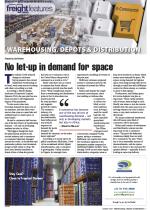The sudden Covid-induced change in consumer buying patterns has turned traditional warehousing on its head, with some sectors booming and others screeching to a halt.According to Martin Bailey, chairman of Industrial Logistic Systems (ILS), the past year has not been easy due to the fragmented impact of the pandemic.“In the sectors that were booming, demand for space was at an optimum, but then there were sectors that came to a near halt and suddenly had too much space on their hands.”He said e-commerce had become one of the key drivers of warehousing demand – not only in developing markets but also in Africa.“The biggest change has been the phenomenal growth in the courier industry and e-commerce as consumer behaviour changed around the world. As lockdowns and quarantine policies were instituted, people turned online to shop. We don’t have detailed numbers in South Africa of what the growth has been in e-commerce, but in the United States the growth is estimated at as much as 50%.”Bailey said there was no reason to assume that South African e-commerce growth was that much lower. “What complicated matters from a warehousing and distribution point of view is that there was massive growth for some products and negative growth for others. The cosmetics industry, for example, which has traditionally been bullet proof, was severely impacted as demand for goods dropped. The demand for vitamins, on the other hand, exploded.”According to a recent report by global consultants McKinsey, Covid-19 has accelerated Africa’s digital transformation, and e-commerce is growing fast. Online retailers in Nigeria, for example, have experienced a doubling of revenue in the past year.McKinsey estimates projected annual e-commerce sales for the continent of around $75 billion by 2025.Bailey said despite the tough economic environment, there was nothing to indicate that e-commerce in Africa was likely to slow down anytime soon, driving a need for overall logistics, but more especially specialised warehousing and distribution.Tim White of property and construction company Profica agrees, saying e-commerce fulfilment can require four times the warehouse capacity in the destination market compared to traditional logistics models. “Also, through Covid-19 and other supply chain shocks, companies want to keep more inventory on hand, which means more demand for space. We expect strong demand for logistics space, from large storage hubs down through to small last-mile fulfilment centres in urban centres, to continue to grow in key regions.”Furthermore, said Bailey, space for reverse logistics was just as important. “Some online retailers talk of return rates as high as 22%. Ideally one wants to run the reverse logistics into the same space you are moving volumes out of as it makes sense to run one’s couriers in two directions.”For many traditional warehouses this will mean some kind of conversion will be necessary.Bailey said location of warehouses and distribution centres was also important in the e-commerce sector. “The good old-fashioned warehouse simply does not work for e-commerce,” he said. “There has to be a reasonable amount of decentralisation, and the spaces have to be closer to the customer for quicker delivery – especially if one is looking at same-day delivery.E-commerce has become one of the key drivers of warehousing demand − not only in developing markets but also in Africa.– Martin Bailey“

